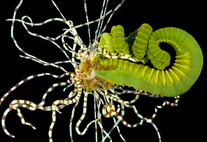Abstract
We document herein the occurrence of three species of Sabellariidae at Lizard Island, Great Barrier Reef, including a new Lygdamis species. Sabellaria lungalla, described from Northern Territory, is reported for Queensland for the first time. The genus Gesaia, represented by a planktonic larva collected in shallow waters of the Archipelago, is a new record for Australia. Lygdamis nasutus n. sp. is characterised by one of the most conspicuous median organ described in the family (cylindrical, distally pigmented and is provided with a flattened, teardrop corona), its paleae morphology (with straight paleae, outer ones with asymmetrical pointed tips and subtle thecal sculpture and inner paleae with blunt tips and smooth surface), three lateral lobes on chaetiger 2, abdominal chaetigers with two type of neurochaetae, and notopodial uncini with 1–4 longitudinal rows of teeth. Comparison of the external morphology of the medial organ and median ridge of several species has been undertaken. Even though its function remains uncertain, the median organ morphology seems species specific and may provide relevant information about the evolutionary history and adaptations of sabellariids.

